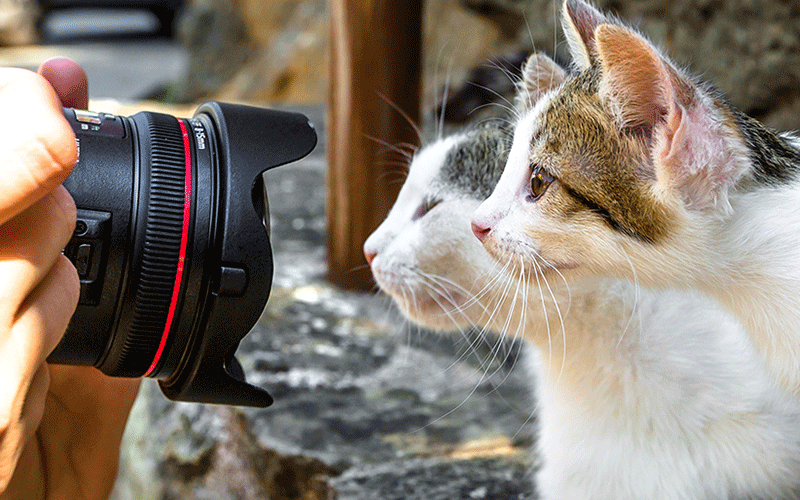(This post was originally published on March 24, 2016 and has been updated to be more awesome.)
Whether it’s a picture of a puppy coming in for its first checkup or a pet owner smiling beside their pet after a successful procedure, practices have amazing marketing-photo opportunities every day.
Sure, stock photos have their place, like when you need a crystal-clear, high-quality image for a brochure or website banner. However, when it comes to engaging both current and prospective clients, real photos of real people and pets work better because:
- They look authentic and are more personal than stock photos.
- They put a face to your practice and help potential clients picture their own pet visiting you.
- Clients typically get excited about the prospect of seeing their pets featured by your practice.
- Even better, clients often share such posts with friends and family, which expands awareness of your practice.
- They allow you to update clients about the progress of their pets.
Said more simply, real photos of clients and their pets make you look like an awesome clinic! Before you whip out your camera or smartphone, though, there’s one big thing to consider.
Getting Client Consent
Before you use a client’s image or name (or feature their pet), make sure the client has agreed to it in writing. While many clients are happy to have images of themselves and/or their pets posted online, there will always be a few who may take offense to your clinic using their image without permission. Getting written photo consent right off the bat can help you avoid awkward situations and better ensure that you don’t accidentally offend or lose clients. Having written consent can also help you avoid being taken to court for publishing an image without permission or having a client demand compensation for using their image and/or their pet’s image.
You won’t necessarily need a lawyer to create a photo consent form. Consulting a lawyer is certainly advisable under some circumstances, like when you need a consent form for a professional photo shoot with pet models. However, for smaller things like photographing patients and their pets to post to your social channels, a basic consent form should suffice in most cases.
What to Include in a Consent Form
You don’t need to be a lawyer to write a consent form, but here are some things to make sure you include in the document:
- Consent to photograph both the client and their pet
- Consent to use both the pet’s name and client’s name
- Permission to use and publish photographs both in print and digitally
- The length of time that photographs will be used (e.g. in perpetuity, for up to one year, etc.)
- Whether or not the photo can be modified by your practice
- That the client waives the rights to any royalties or compensation for the use of a photo
- The client’s signature and the date the consent was signed
Consent Form Template
Click here to download your FREE consent form template.
You can alter this consent form for use in your practice, and it’s simple to change. (It’s just a Word document.) But please note. We are not lawyers, and this does not constitute a legal document. If you have any concerns about this consent form, please consult with a lawyer.
Another important thing to help avoid legal issues is controlling the devices on which patient photos are taken. Any photos of clients/pets should ideally be taken using practice-owned devices. This prevents any problems that could arise from situations such as staff members having work images on their personal devices. Also, make sure team members are clear on the purpose of taking client/pet photos, the importance of written consent, and what those photos can and can’t be used for (e.g. personal use).
How to Ask for Consent
- Work it into your workflow.
Some practices make it a point of photographing all incoming patients. If you have a designated person or group at your practice that you’ve armed with a camera and the task of photographing new patients, arm them with a consent form too. When they ask whether they can take a photo of a patient, have the client read over and sign the form at the same time.
2. Include the consent form with other things that clients are already signing.
If you have a registration or appointment form, you can include the consent form in the list of things to which clients agree. Or add the consent as a secondary form to fill out while they’re filling out a registration or appointment form. It’s important to make sure the client knows/notices they’ve agreed to photo consent. Whatever you do, don’t put photo consent in any fine print. You want to be as transparent as possible about asking. If a client says no, that’s okay. It’s better to have no photo at all than an angry client on your hands.
3. Don’t be shy.
Don’t be nervous or afraid to ask clients to fill in a photo consent form. Clients appreciate it when you make a point of getting permission before you post images of them and/or their pets online. Asking for consent shows that you respect their privacy, and most of your clients should be thrilled that you want to photograph and feature their furbaby.
Ultimately, Your Client Consent Form Shouldn’t Trump the Clients Themselves
If a client has a change of heart and requests that you remove an image from your website or social channels, we recommend doing so to the best of your ability, with the caveat that once an image is on the internet, the image may be out of your control.
Did you know that LifeLearn WebDVM custom veterinary websites integrate your social media directly into your website? And with WebDVM, you can easily manage, schedule, and post across multiple channels from one location.
Discover why more veterinarians choose WebDVM






